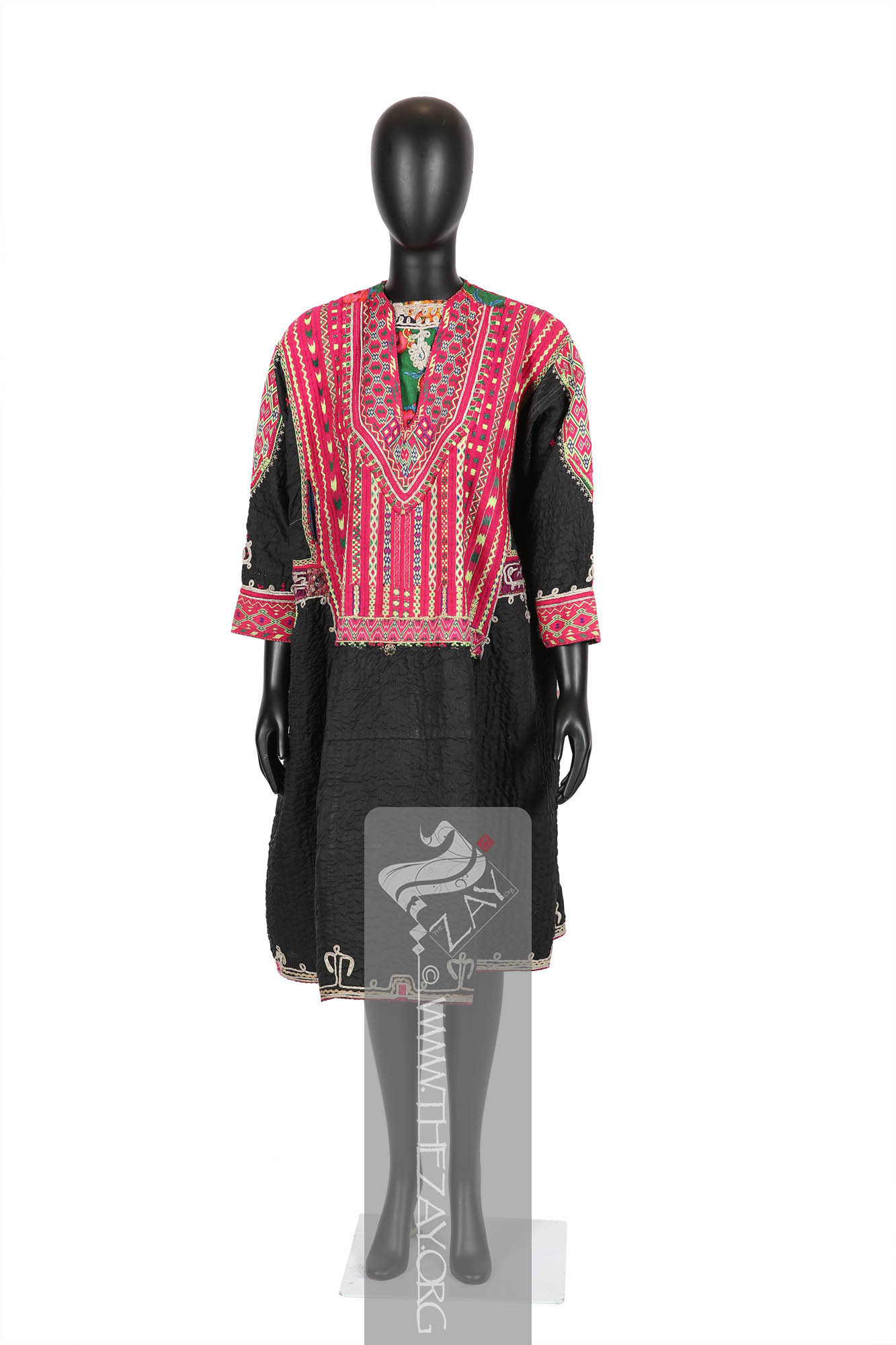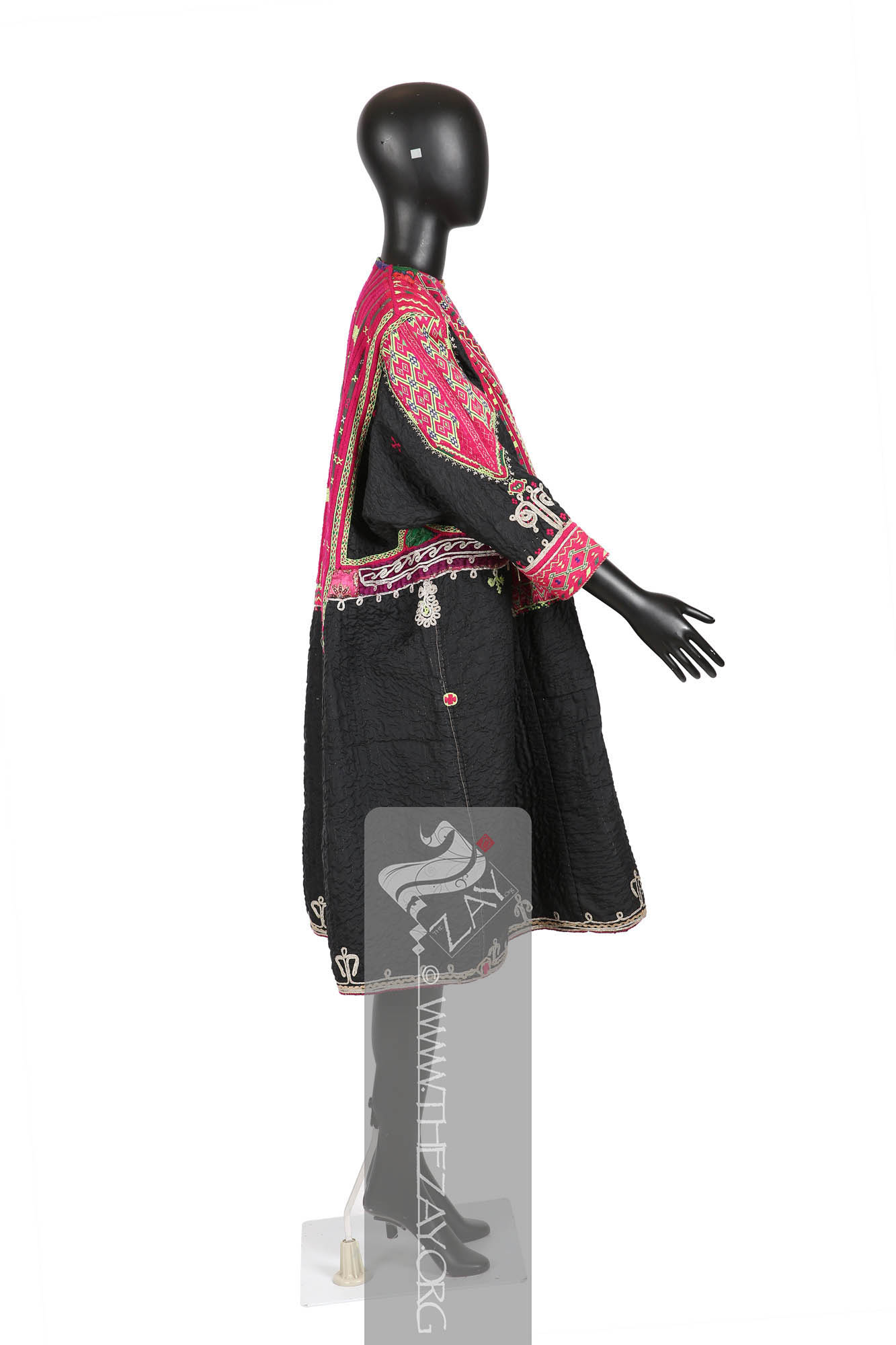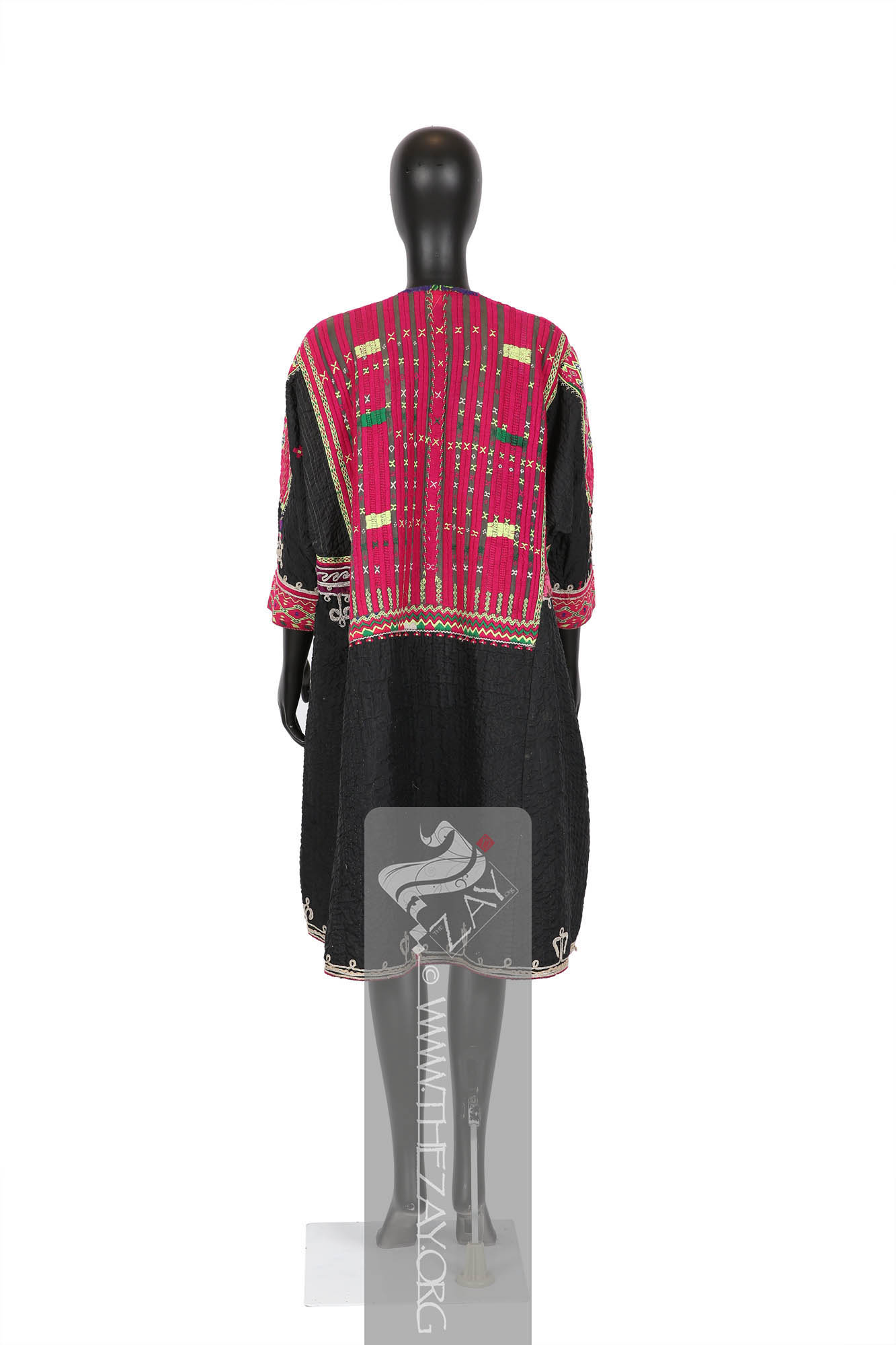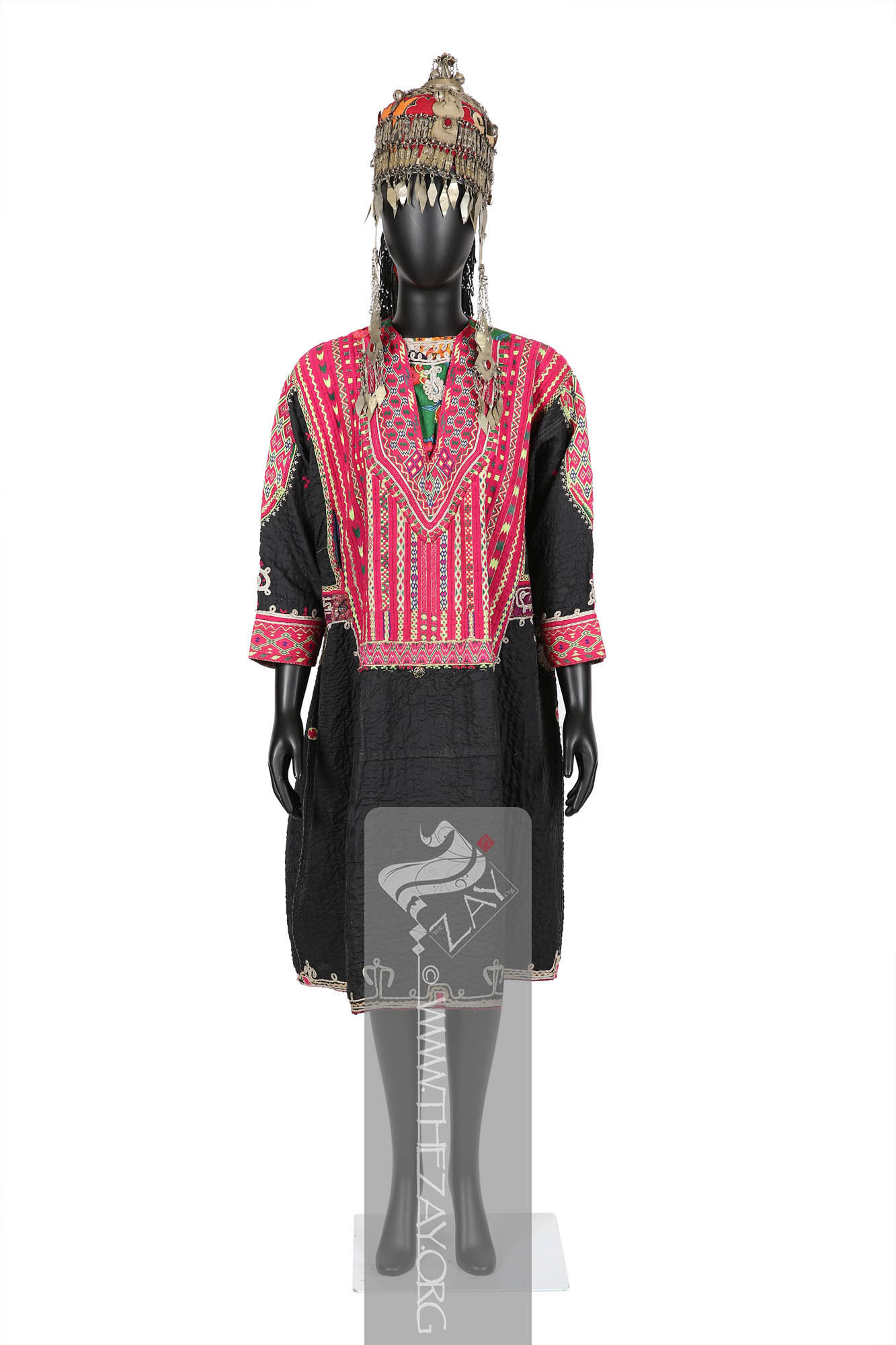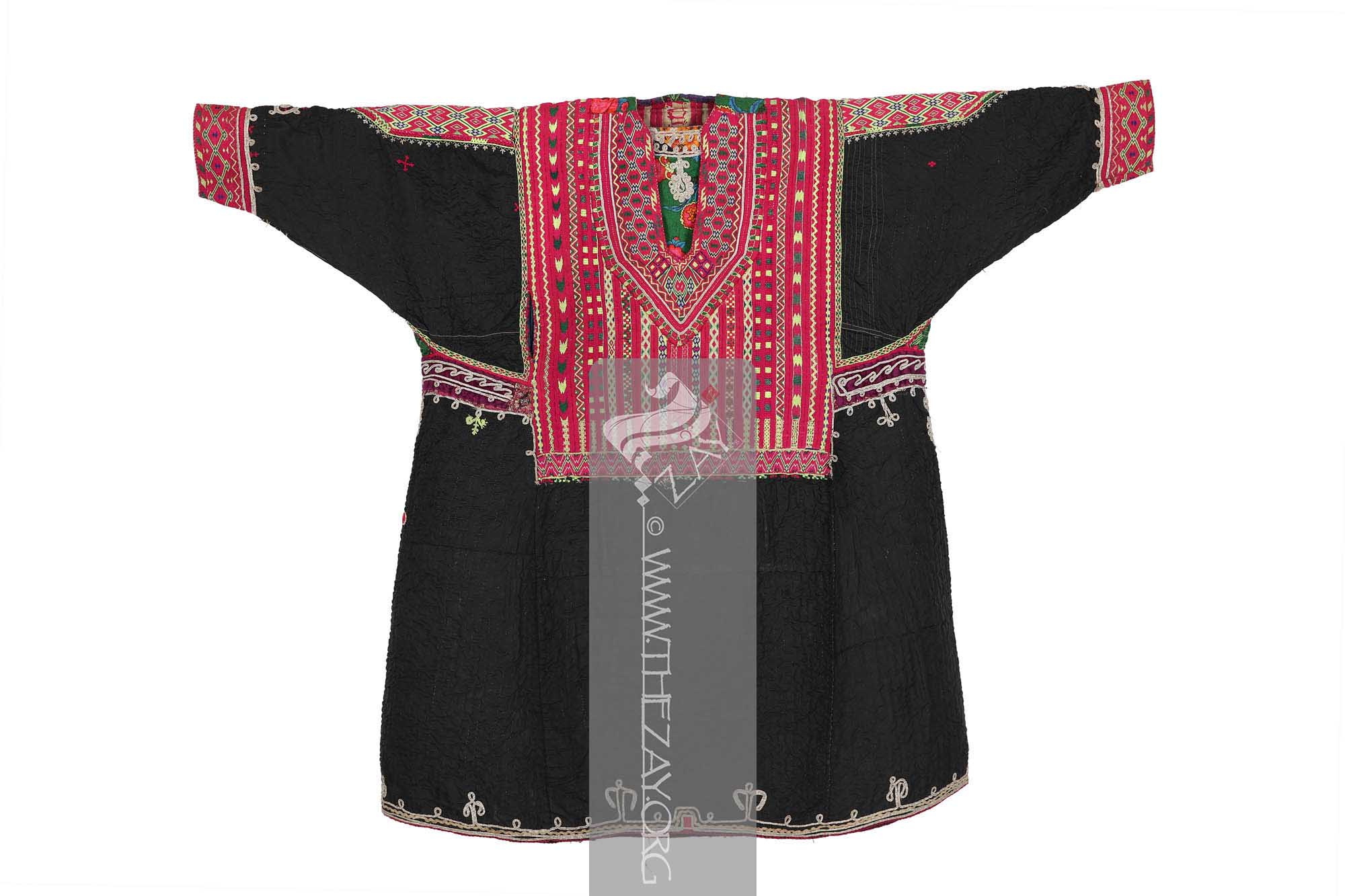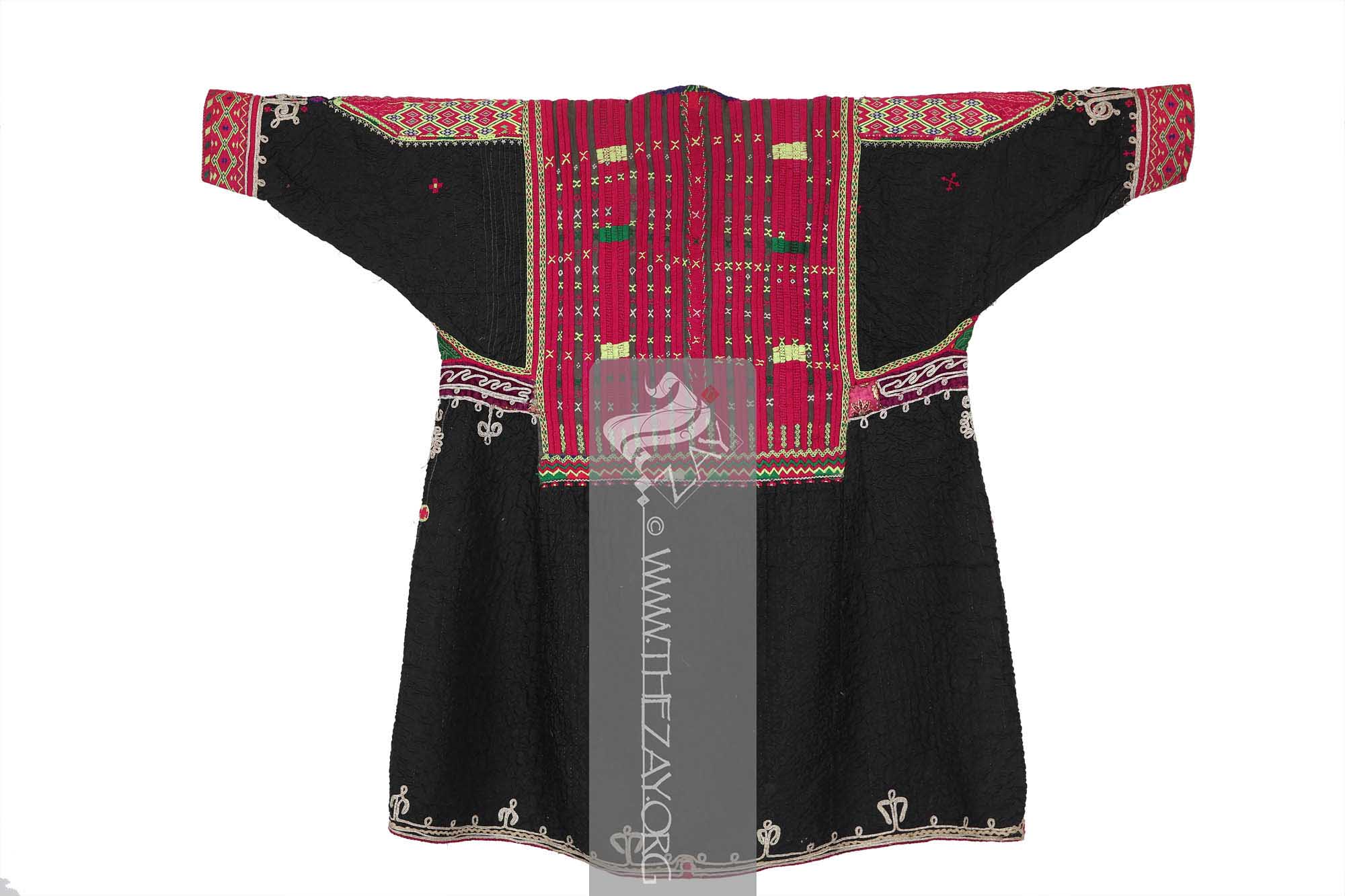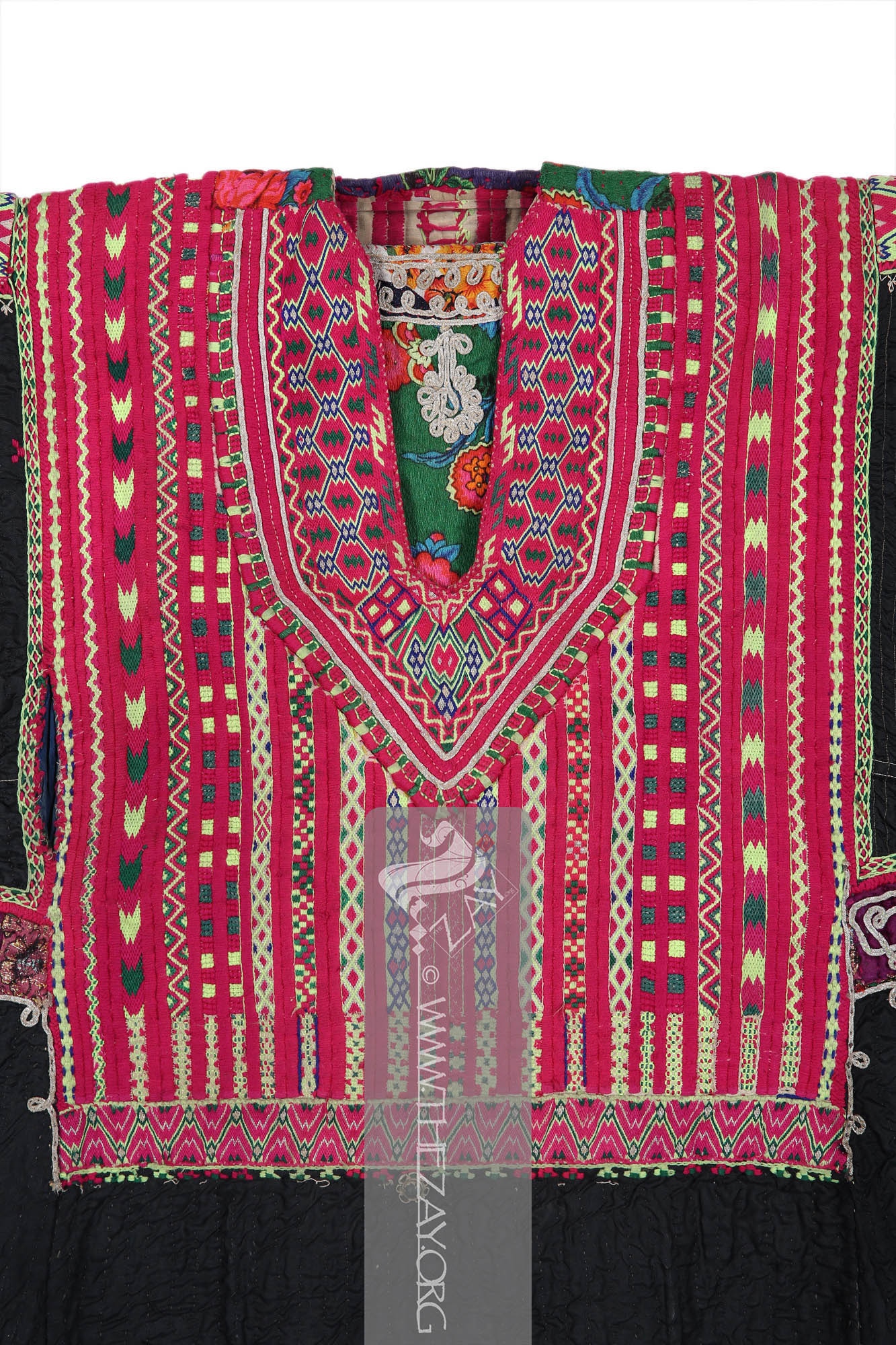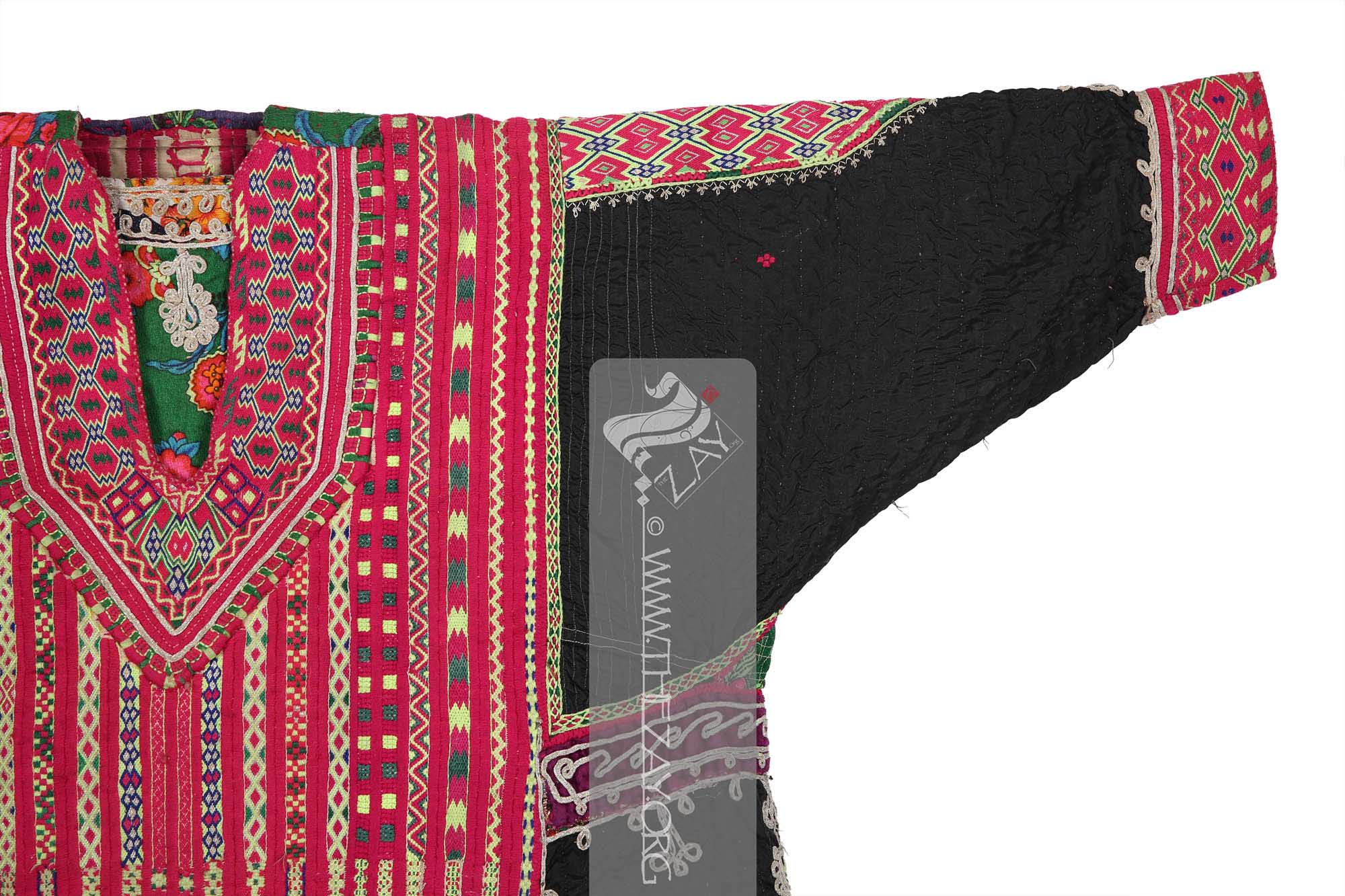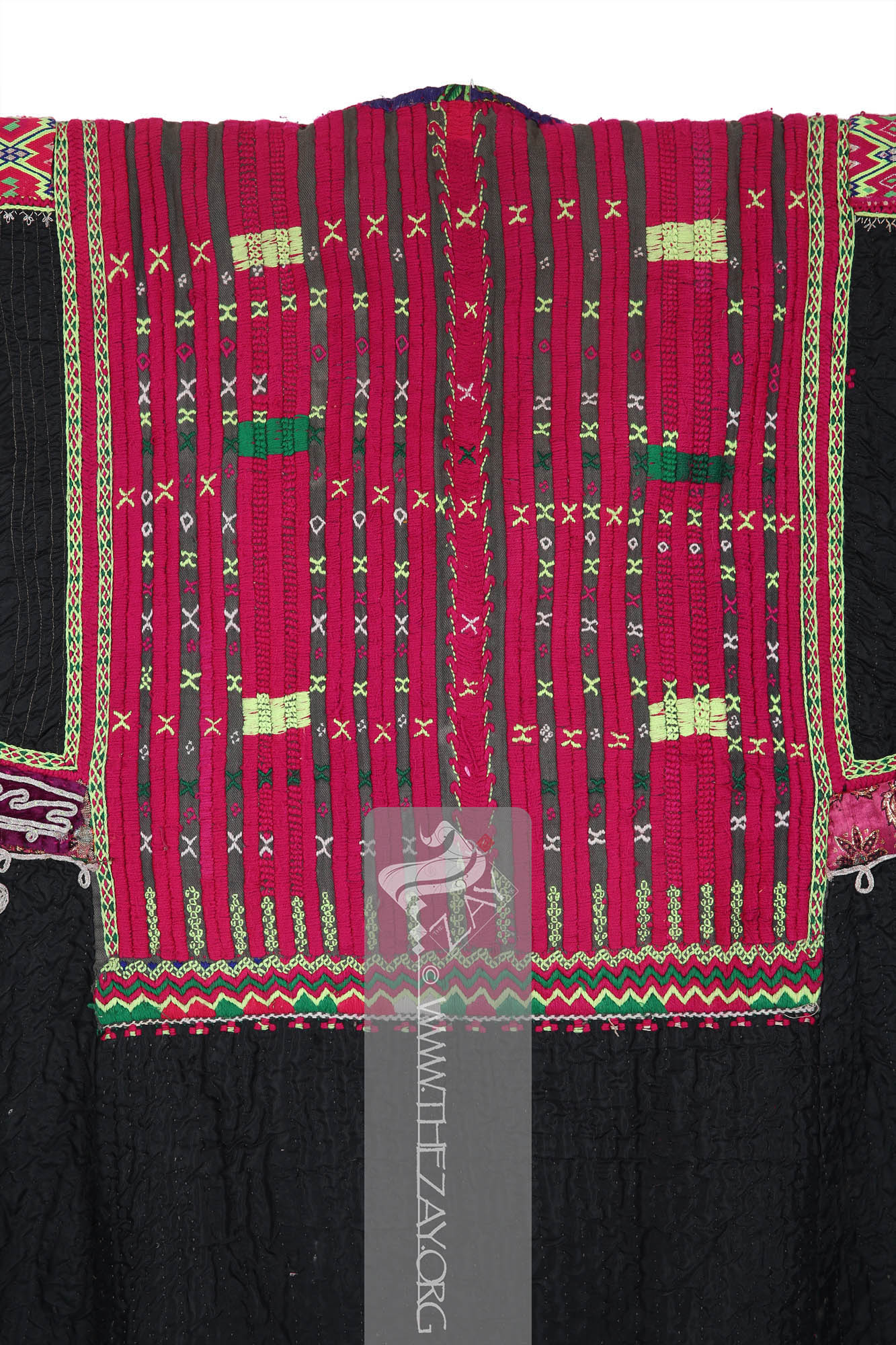Object HistoryThis colourful woman’s tunic possibly belonging to the Kalash tribes native to the Chitral Valley of Pakistan and the neighbouring Nuristan province of Afghanistan, was part of the Sheila Paine Collection. It was purchased by
Dr. Reem Tariq
Ṭariq: (Arabic; Synonym: tulle_bi_talli
Tūlle_bi_tallī: (French: Tulle – a city in France where fine material for veil was first made; Turkish: tel – wire; Synonym: tariq; talli; badla; khus_dozi ), series of small metal knots made on a woven net ground as embellishment. The term is commonly used in the North African Arab region specifically in Egypt.
; talli; badla; khus_dozi ), series of small metal knots made on a woven net ground as embellishment. The term is commonly used in the Levant Arab region specifically in Lebanon.
El Mutwalli
Dr. Reem Tariq
Ṭariq: (Arabic; Synonym: tulle_bi_talli
Tūlle_bi_tallī: (French: Tulle – a city in France where fine material for veil was first made; Turkish: tel – wire; Synonym: tariq; talli; badla; khus_dozi ), series of small metal knots made on a woven net ground as embellishment. The term is commonly used in the North African Arab region specifically in Egypt.
; talli; badla; khus_dozi ), series of small metal knots made on a woven net ground as embellishment. The term is commonly used in the Levant Arab region specifically in Lebanon.
el Mutwallī: Founder (CEO) of the Zay
Zay: (Arabic: costume, Pl. azyaā’), a set of clothes in a style typical of a particular country or historical period. Initiative, a public figure, speaker and author. An expert curator and consultant in Islamic art and architecture, interior design, historic costume, and UAE heritage. from Kerry Taylor Auctions, London in 2020. It was eventually added to The
Zay
Zay: (Arabic: costume, Pl. azyaā’), a set of clothes in a style typical of a particular country or historical period. Initiative.
Sheila Paine (1929-2022) was a renowned traveller and one of the foremost authorities on traditional tribal textiles and embroidery of Central and South Asia, Near and Middle East and North Africa. A teacher of modern languages, Ms Paine started her collection with English samplers, however, the loss of her husband in 1974 coupled with her love for textiles introduced her to a richly decorated piece from the ‘Kohistan’ – a region shared by Iran, Tajikistan, Afghanistan, and Pakistan – at a dealer’s shop in London triggered her passion for textile research.
She started travelling extensively to the remotest places from Central Asia to Russia, South Asia to the Middle East and Northern Africa collecting textiles.
Her travels resulted in a trilogy of travel books which brought her to the limelight amongst museum professionals, academics, and researchers. She collaborated with several museums – The British Museum, London and the Pitt Rivers Museum, Oxford – to exhibit her collection and photographs as well as publish several books on her textile collection.
In 2008 she sold her collection at an auction at Dreweatts following which her travel came to a sudden halt at the age of 80 after a severe medical limitation. Despite her travel pause she continued to write and exhibit until 2017. She passed away at the age of 92 in March 2022.
Object FeaturesThis is a black silk (
satin
Sātin: (Arabic: Zaytuni: from Chinese port of Zayton in Quanzhou province where it was exported from and acquired by Arab merchants), one of the three basic types of woven fabric with a glossy top surface and a dull back. Originated in China and was fundamentally woven in silk.) woven tribal woman’s traditional tunic dress with woollen and metallic thread embroidery. A tunic style shift dress with heavily embellished (
bodice_yoke
Bodice_Yoke: (Synonym: Yoke
Yoke: (Synonym: Bodice_Yoke), a structured pattern fitted at the shoulders defining the structure of women’s garments. Introduced in c. 1880s it defines the transition between the upper and lower parts of the garments and can now be found stitched-in where the blouse is separated from the skirt by a horizontal seam. ), a structured pattern fitted at the shoulders defining the structure of women’s garments. Introduced in c. 1880s it defines the transition between the upper and lower parts of the garments and can now be found stitched-in where the blouse is separated from the skirt by a horizontal seam. )/(
yoke
Yoke: (Synonym: Bodice_Yoke), a structured pattern fitted at the shoulders defining the structure of women’s garments. Introduced in c. 1880s it defines the transition between the upper and lower parts of the garments and can now be found stitched-in where the blouse is separated from the skirt by a horizontal seam. ) front and back this dress is a typical Kalash tribal woman’s attire from the Chitral Valley of Pakistan.
The front of the
yoke
Yoke: (Synonym: Bodice_Yoke), a structured pattern fitted at the shoulders defining the structure of women’s garments. Introduced in c. 1880s it defines the transition between the upper and lower parts of the garments and can now be found stitched-in where the blouse is separated from the skirt by a horizontal seam. is embellished with separately woven woollen patches in pink, blue, yellow, and green mostly featuring geometric designs with a v-shaped opening that is covered by a plain grey cotton flap sewn from the underside with a printed green woollen patch.
A corner of the flap has a stud button possibly made of aluminium for fastening. A silver colour metallic thread or corded ribbon sewn to the ground fabric in (
couching
Couching: (Latin: collocare – Place together), in needlework and embroidery couching is a technique in which yarn or other materials are laid across the surface of the ground fabric and fastened in place with small stitches of the same or a different yarn
) style is also used as an element of embellishment. This metallic cord is looped around to form floral and scallop motifs.
The sides around the waist have an embellished violet velvet patch with colourful thread and metallic trimmings. The shoulders and the top of the sleeves are also embellished with patches of pink wool work. The front of the
yoke
Yoke: (Synonym: Bodice_Yoke), a structured pattern fitted at the shoulders defining the structure of women’s garments. Introduced in c. 1880s it defines the transition between the upper and lower parts of the garments and can now be found stitched-in where the blouse is separated from the skirt by a horizontal seam. has a combination of woven and embroidered wool work.
The cuffs are embellished with colourful patches woven in wool. The back of the
yoke
Yoke: (Synonym: Bodice_Yoke), a structured pattern fitted at the shoulders defining the structure of women’s garments. Introduced in c. 1880s it defines the transition between the upper and lower parts of the garments and can now be found stitched-in where the blouse is separated from the skirt by a horizontal seam. is constructed of a brown cotton fabric almost entirely covered with woollen embroidery in (
satin_stitch
Satin_stitch: (Synonym: Damask Stitch), is a type of flat embroidery stitch that creates a satin like smooth and shiny surface by closely spaced stitches, covering an entire area or shape.) style creating rows of thick and thin lines running parallel to each other, and geometric shapes in pink, green and yellow. The skirt has a small coin pocket in the front.
The entire dress is filled with tiny quilting-style running stitches. The hemline has a border with silver colour metallic and woollen corded threads. The front of the
yoke
Yoke: (Synonym: Bodice_Yoke), a structured pattern fitted at the shoulders defining the structure of women’s garments. Introduced in c. 1880s it defines the transition between the upper and lower parts of the garments and can now be found stitched-in where the blouse is separated from the skirt by a horizontal seam. and the skirt of the piece is lined with plain ivory thick cotton with black quilting style running stitch.
Interestingly Kalash is an indigenous non-Muslim tribal community native to the Chitral Valley of Khyber Pakhtunkhwa province – previously known as the North West Frontier Province – of Pakistan, and the neighbouring Nuristan province – previously known as Kafiristan – of Afghanistan. Although the population of this community has dwindled over the years in Afghanistan, there is a sizable population still existing in the present-day Chitral Valley of Pakistan.
Links
- Video on Sheila Paine: https://vimeo.com/189136778
- BBC Podcast: The Last Word (Madeleine Albright (pictured), Peter Padfield, Christina Smith, Sheila Paine): https://www.bbc.co.uk/programmes/p0bz9dlk
- Valérie Bérinstain, Mary Hunt Kahlenberg, Zaira Mis, Marcel Mis. Asian Costumes and Textiles from the Bosphorus to Fujiyama: The Zaira and Marcel Mis Collection. California: Skira, 2001.
- Suleman, Fahmida. Textiles of the Middle East and Central Asia (British Museum) The Fabric of Life. London: Thames and Hudson, 2017.
- Embroidery from Afghanistan Fabric, folios. Sheila Paine. Washington: University of Washington Press, 2006.
- Sukhareva, Olʹga Aleksandrovna. Suzani
Suzani: (Farsi: suzandozi : needlework, from Farsi: suzan: needle, dozi: embellishment), type of embroidered and decorative Central Asian tribal textile art usually on a cotton fabric, embroidered in both silk or cotton thread with primarily chain, satin, and buttonhole stitches as well as couching technique. : Central Asian Decorative Embroidery. Samarkand: SMI Asia, 2013.
- https://www.thetimes.co.uk/article/textiles-expert-who-travelled-solo-around-central-asia-tddtc36dt
- https://www.prm.ox.ac.uk/event/stitch-of-a-symbol
- https://www.encyclopedia.com/arts/educational-magazines/paine-sheila-1929
- https://www.theguardian.com/theguardian/2022/mar/27/sheila-paine-obituary
- https://oxfordasiantextilegroup.wordpress.com/tag/sheila-paine/




